|
|
Mountain/Rock |
|---|---|
|
|
31.06680°N / 81.31820°E |
|
|
Ali/Shiquanhe Prefecture |
|
|
Hiking |
|
|
21778 ft / 6638 m |
|
|
Overview
Kailash is locally more known as Kangrinboqe (Feng). It is the highest mountain in the western part of Gangdise Shan. The surroundings are very beautiful, with Lake Manasarovar close by and the gigantic Gurla Mandata (7728m) in the distance.
The mountain is sacred and therefore it's not allowed to climb to its summit. An odd thing with Kailash is that it's not holy only for followers of one religion, but for three! Buddhists, Hindus and the followers of the Bön religion all see the peak as sacred.
There are large amounts of pilgrims going to Kailash every year. Their main aim is to walk a so called kora, which is a circumnavigation of any object considered sacred. It can be a rock, a shrine, a mountain or even a whole mountain range. A turn around Kailash is suppused to be one of the most important ones a Buddhist can do and according to the myths you'll be granted nirvana if you walk 108 times around the peak. It's quite an achievement if you do it, as the kora is 53 km long.
Getting There
Kailash is a long way from everything and count on at least ten days from home to the foot of the peak. Most people want to play it safe and acclimatize properly and set more days aside for the journey to the mountain.
Starting Points
These are the most common ways to travel from and to a starting point.
Beijing - Lhasa
Kathmandu - Lhatze
Kathmandu - Saga
Bishkek - Kashgar
Beijing - Urumqi - Kashgar
Almaty - Urumqi - Kashgar
New Dehli - Darchula
There are four main ways to reach the peak.
- Xinjiang Highway Kashgar - Shiquanhe - Kailash
There are really a lot to be said about this route. It's extremely desolate, barren and possibly the one that stays on the highest elevation for the longest period of time. Starting from the oasis city of Kashgar, you travel on the brink of the Takla Makan desert ( the world's second largest sand desert) for 270km. Just after Yecheng you leave the Southern Silk Route and head straight for the heart of the Karakorams.
A slow climb through an area often frequented by huge tornadoes, you reach the little settlement of Aqmeqit. From here on there are a lot of ups and downs. The first high pass is the huge Chiragsaldi at almost 5000m. It's infamous for its really bad and fast changing weather. On the south side of the pass, you'll arrive in Mazar, the last outpost of civilization for the climbers heading for K2.
Some more high passes have to be travelled before you arrive on the Aksai Chin plateau. It has been called "emptiest place in the world" and I wouldn't contest that. In the end of this plateau you have to go over the multiple pass on the eastern side, which have elevations at almost 5400m. The road drops slowly to the Shiquanhe/Ali valley, where it at times can be very sandy and hard to travel.
Be sure to go along the southern road towards Kailash from here. The last day of travel to the peak can be hard due to small rivers crossing the road at many places. - Northern Route Central Tibet (Lhasa or Lhatze) - Tsochen - Shiquanhe - Kailash
Another very hard and desolate route. It's considered a bit dangerous to travel in the winter as the temperatures drop very low, there are little traffic and if the vehicle breaks down, you're in a serious situation.
Starting from Lhatze in central Tibet, the route climbes slowly but surely over many small passes. There are quite a lot of settlements along the first 200km. When arriving in Raka, a little check point, you're at the foot of the central part of the Gangdise Range. Turn north/right 7km after Raka. You're now in the wilderness for real and also, you'll stay over 5000m for the next 150km. Be sure to have acclimatized really good before setting off for this stretch en route. It's here you also travel the highest road pass on earth - the mighty Semo Pass at 5575m!
A slow descent takes you to Tsochen, one of the only two larger settlements along the route to Shiquanhe. More passer over the northern part of the Gangdise range are awating you before you drop down to the brink of the Chang Tang (Tibet's uninhabited northern part). Gerze is passed and series of passes, desolate plateaus, salt lakes and real wilderness takes over for the next 500km. A lot of the Chang Tang's unique wildlife can be seen here. Wild Yaks, wolves, Chirus, gazelles, wild donkeys and possibly bears and lynx are around.
A corrugated, washboard nightmare of a road takes you the last couple of hundred km into to Shiquanhe. From here, to Kailash, same as the route above.
Southern Route Central Tibet (Lhasa or Lhatze) - Saga - Kailash
A shorter and usually easier route from central Tibet to the peak. Leaving Lhatze west bound, you go the same way as described above (Northern Route) to Raka. At the turnoff 7km after Raka, you go straight ahead towards Saga, which you reach after 1 ½ h and a huge switch-back drop later. Saga is situated in the Yarlung Tsanpo Valley and has a short cut connection to Nepal. There is a small ferry operating from the river banks of Saga, transporting two cars at the time to the other side of the huge river. The ferry service is not working in the colder seasons. No fixed dates for opening or closing. A bridge is being built at the time of writing. It's a long day's travel to the Nepali border from Saga.
Continuing towards Kailash, there are many passes and bridges to cross. On clear days you have excellent views of the high Himalayas and Annapurna and Dhaulagiri can be seen. Most of the time the road is following the river Tsangpo and raod conditions are good (Tibetan standard) but at times you encounter deep sand. The last part to Kailash is a desolate stretch over one of Tibet's most sacred passes - Mayum Pass/La at 5220m. You have excellent views of the gigantic Gorla Mandatha (7700m) and the holy Lake Manasarovar. - India/Nepal Border New Dehli - Purang/Burang - Kailash
An expensive alternative, full of red tape and uncertainties if you're able to cross the border or not. This route can be closed with no prior notice, if some political issue between India and China comes up. The best way to get any info about the current situation is to ask the tour operators in Kathmandu. On top of the "old" border problems, the route is now plagued with the risk of ending up in Maoist territory in Nepal. Not the recommended route and I can't see the reason why to choose this one when there are interesting and better options on the actual plateau. On top of the issues mentioned above, there are also some non-honest organizers ripping off travelers on this package.
A link to a group which were ripped off . A story I, sadly, have heard too many times. Watch out!
There's also a variation of the northern route, cutting straight down south from the Gerze area, but it's very uncommon and this outback route can only be travelled by walking or biking. Sometimes the pilgrims take a shortcut here. Mail me for details about this one.
Arrival At Kailash
Some things to think about.
Regardless of where you arrive from, it's a bit shocking to arrive in the chaotic settlement of Darchen. You have many days of travelling through the middle of nowhere behind you and all of a sudden there are hordes of people around you at all times. You can pitch a tent anywhere here, but to get some sleep and piece of mind, it's better to do so inside the walls of the camp. If you have arrived here without a permit, the PSB will find and fine you. No problem, many travelers do and it's standard procedure. More about this in the next section.
You may have gotten used drinking the crystal clear and safe water of Tibet directly from the streams - Don't even think about doing so around Kailash! Most streams here double as toilets and a place where you wash clothes and the dishes.
Watch out for dogs!
It's no lap-dogs either, but huge Tibetan Mastiffs, usually on the brink of starvation. Take special care at night and never walk without a torch and some "weapon" to protect yourself with. A couple of rocks will do fine. When mentioning the dogs are starved, they are really starved fighting for what you leave in the toilet and that's also the time you have to watch out the most for them.
Theft from the tents are common.
If you have hitch-hiked to Kailash, the truckie may want to drop you a bit out of Darchen in order to avoid some trouble with the PSB.
If you feel ill, you can try out traditional Tibetan medicine and get basic treatment in the small clinic close to Darchen. It was set up by Swiss in the winter of 1997.
Red Tape
Since it's a holy mountain, you can't get a climbing permit.
There is a small fee for walking the kora (A religious ritual, walking around a shrine, mountain or any other holy object), which you pay when starting the trek. You also need an "Alien's Travel Permit", which can be obtained in any major town in the PSB (Public Security Bureau) office. Usually these permits are only issued if you go on an organized tour.
That said, many individual travelers make it without permits (especially from the west, as the PSB in Yecheng and Kashgar are very reluctant to issue permits).
Does it sound risky and stupid?
It's not as bad as it sounds. A lot of adventureous souls do it every year and when they are apprehended in Shiquanhe, there is a "standard procedure fine" of 300-350Y. When you have paid it, you get a reciept and a permit to travel onwards. The PSB are very used to it and many travelers know about this shortcut. Cheaper than paying for an expensive tour. Usually the police in Shiquanhe tells you you have broken the law with a smile and as long as you pay it, you're in no trouble whatsoever.
Mountain Conditions - The Seasons
Some parts of Tibet can be visited at all times of the year, for example the eastern parts. In the west, where Kailash is situated, it can get frigidly cold in the winter. Very few go there in between November and March.
Spring time is beautiful and some lower areas in en route are a riots in color. There can be quite a lot of floodings due to melt-off from the bigger peaks and some bridges may be swept away. Apart from this, it's a good season for Kaliash.
The summer is the time when most people visit the area and it can get a bit chaotic around the peak. The weather is usually stable from early April to June, when the first signs of the monsoon starts to show. Usually, Kailash is not so affected by it, but some years the monsoon passed over the Himalayas for real and then a second flooding period is a fact. Regardless of if it's a strong monsoon or not, August and early September is usually plagued by thunderstorms and sudden heavy rainstorms.
The fall, starting for real in late September is a great time to visit the area, as the sky usually is very clear after the rainy season. The temperatures are still ok, even if the nights start to get chilly.Camping
Camping is officially illegal in China, but no one will bother you if you pitch your tent. All along the way to Kailash there are lots of wilderness and extremely nice campspots. Around the peak itself you may get a bit grumpy or nervy, as you for sure have lots of pilgrims hanging around your tent at all times around the clock. Don't be surprised if someone open up your tent and come in, even go through your gear. If you tell them to stop and get out, they can look very surprised. Different cultures.
Remember many Tibetan pilgrims are extremely poor and the temptation to steal something can sometimes be too tough. Watch your geat at all times.
There are an official campground in Darchen. It's in the middle of the madness and the only reason to stay there is to enjoy the relative calm of the encampment.
Maps
- Interactive map
- Gizi Map from the World Travel Maps. Good for planning and overview. Scale 1:2 000 000 ISBN: 9630080524
- Downloadable maps from Tibetmap.com
- The map of the Kailash area from Tibetmap.com
- A good list of maps of Tibet.
- More maps of Tibet, including the Nepa Trekking map for the Kailash area.
-
Why Kailash Is Sacred
To be honest, I'm very ignorant about religion and the lack of interest for sacred places, religious ceremonies, traditions etc. is almost total. Therefore I may be the last of all SP-members to be picked to write this section.
Hopefully someone else will add information to this section. Someone who's more knowledgable and suitable for the task. For now, some links to informative sites about the topic is all you'll get.
Kailash, the holy mountain.
Kailashzone Many of the names are explained on this site and there are links to tons of info.
Extensive info about Tibetan Buddhism
Wikipedia
A short travel story about walking around the peak.
(Non-guide) Books about the mountain - Circling the Sacred Mountain : A Spiritual Adventure Through the Himalayas
by Robert Thurman, Tad Wise - Walking to the Mountain: A Pilgrimage to Tibet's Holy Mount Kailash
by Wendy Teasdill - Tibet's Sacred Mountain: The Extraordinary Pilgrimage to Mount Kailas
by Russell Johnson, Kerry MoranThe Pilgrims
Kailash is the holiest of all the sacred mountains.
Hindus, buddhists and bön followers are all undertaking pilgrimage journeys to the peak. The Buddhists and Hindus walking the Kora around Kailash, do it clock-wise. The Bön believers do it the other way around.
Usually, the Tibetan pilgrims travel on trucks and the norm is 20 to 50 persons on the back of the famous Dong Feng trucks. It must be one of the harder types of travel you can possibly undertake. For days and days they have to stand up there, regardless of rain, thunderstorms, blizzards, gales, low minus degrees, 5000 meter-plus passes and baking sunshine. The road conditions are some of the worst on earth, with corrugations, sand and river crossings. It's not unusual the pilgrims have to go out and push the trucks out of rivers or mud.
A journey from the east of China to Kailash can take weeks, one way!
Those are the ones who choose the easy way to get there.
The hardcore zealots walk to Kailash, regardless of where in China they live. To make things worse, they don't just walk the normal way. They make the prostrating procedure after every step.
It goes like this:
Walk one step. Get down on your knees. Prostrate completely and put your forehead to the ground. Get up. Walk one step...etc. until you reach Kailash (or any other holy destination). The walk back home is usually done in the same way.
The long journey to Kailash is something every devout Buddhist want to do at least once in life. Unfortunately, many are poor people who just have the means to support such a journey. The long way takes its toll and some never make it to Kailash. Around the mountain and especially in the camp/tent settlement of Darchen, the sanitary conditions are horrible. If a Buddhist die, he or she is supposed to get a sky burial. Your remains are hacked up to smaller pieces and put on an altar for the birds of prey. Around Kailash there are too much people for the vultures and there are also a lot of dogs. This leads to some quite morbid scenes where dogs fight about the human remains.
The pilgrims usually walk the kora in a day, but the norm for foreign tourists is longer. Count on two or three days.Unclimbed?
Climbed?
Unclimbed?
As with other holy mountains (Machhapuchare, Meili Shue Shan etc.) there are a lot of speculations if the peak has been climbed or not.
Some of the stories that have been around for a long time. - A spanish team got a permit in the early 90's. According to one storyteller, it was revoked by the Chinese because of massive protests from the local Tibetan government in Lhasa. Another story claims, the Spaniards pulled out themselves when they really understood the implications of climbing Kailash. It included being pariahs in the climbing community etc.
- The story about the two "Swedes" who supposedly climbed Kailash. This story I can clarify as I was one of the persons who were blamed for having climbed the peak. Even on this site it is mentioned. Here is how it was:
I travelled by bicycle with a Swiss guy (Sweden and Switzerland is the same or mixed by a lot of non-Europeans) through Asia. This Swiss, we can call him S, had been in Tibet before and had for various reasons started to dislike Tibetans. When in an arguement with a fanatic pro-Tibet person S said a lot of stupid things. One of them was: Well, I'm going to climb that piece of shit peak and piss on the summit! The person was horrified and left.
The rumor about a crazy Swede and his friend obviously spread. People started to talk about the persons who were going to climb the holy peak. S, found it amusing and did his best to be "secretive" towards persons he liked and quite frank about him going to summit the peak towards people he disliked.
After some time travelling with the Swiss, I realized he had a screw or two loose and decided to split from him. I didn't think much about the "climbing-Kailash-story" until I arrived in a small town in central Tibet. A climber, who had been attempting Xixabangma asked me if I was one of the two cycling idiots who had climbed Kailash. I told him the story and he said the talks of the Kathmandu climbing community was a lot about the Swedes who had climbed Kailash. I got this confirmed when I arrived in there. I overheard a discussion in a bar, in which one person even claimed to have seen the two (us) on the summit.
So, this story holds absolutely no substance of truth. I know for sure S didn't climb the peak and I'm even more certain I didn't :-) - Another fairytale is that Messner climbed Kailash. A nocturnal speed-climb that no one saw. Yeah, right.
If you have any other fascinating stories to tell on this issue, please let me know.
Officially, the peak is unclimbed. Period.Getting There - Organizers
There are hundreds of companies who offer package tours to Kailash. I have arrived to Kailash by bicycle, so I can't recommend any special. I have been dealing with these guys before and they are great:
Shigatse Travels. Based in Lhasa, joint venture Dutch/Chinese/Tibetan and have business partners in Kathmandu.
Try out a search. You get a lot to choose from!
External Links
- Mt. Kailash
In the Martin Gray "Sacred Sites" pages. - The Oriental Caravan
Some nice photos. - Mount Kailash: the holy mountain
Written by Lisa Maliga


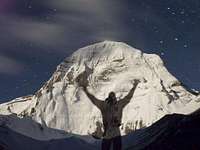
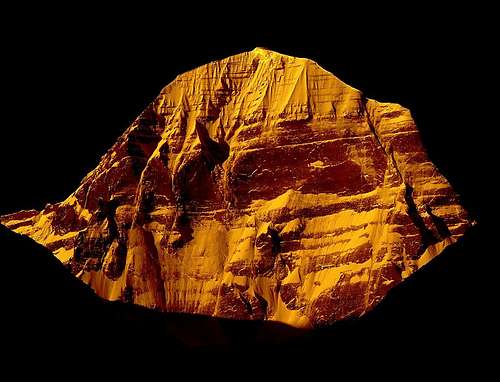
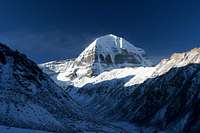

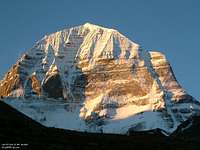
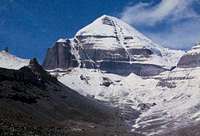
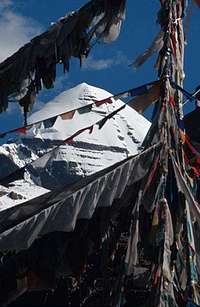
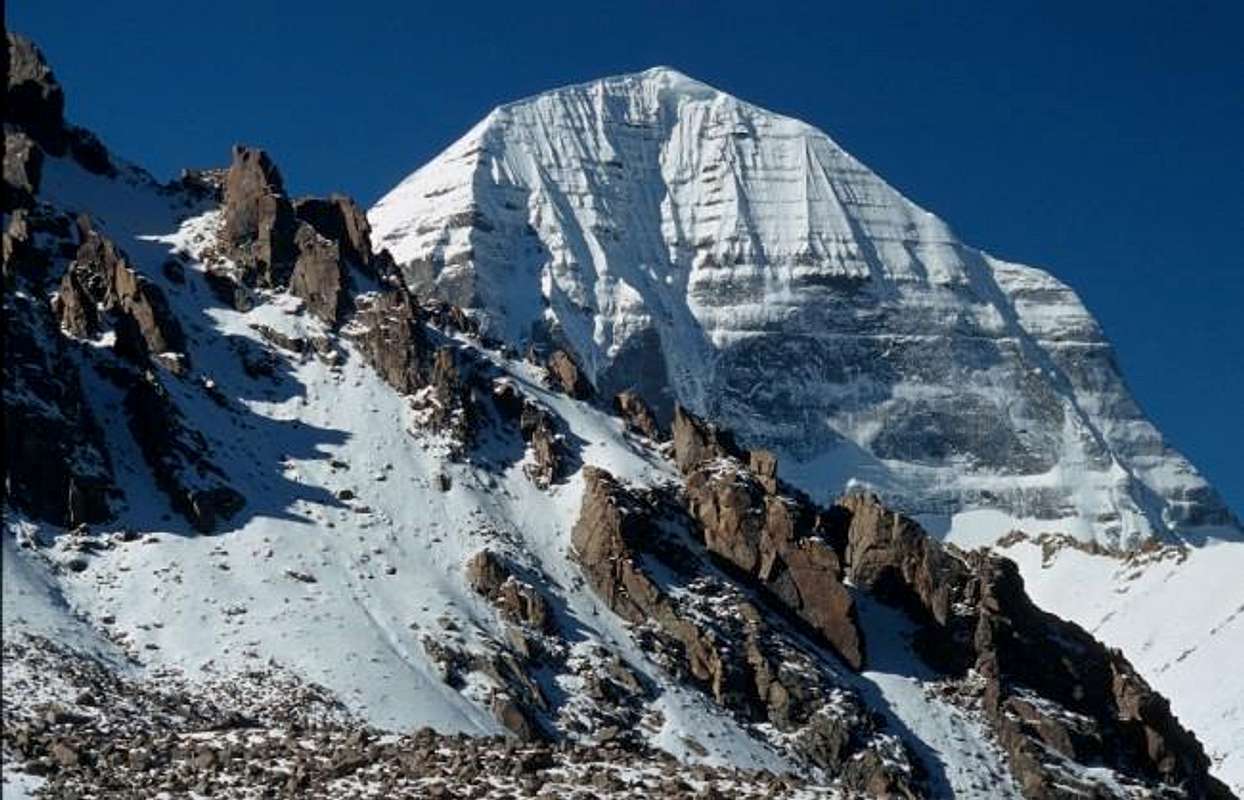

AriehDavid - Feb 5, 2008 2:04 pm - Hasn't voted
4 ReligionsJust to mention, Kailash is sacred to the faith of Jainism as well. So it actually is important to 4 religions! Beautiful.
Corax - Feb 5, 2008 7:18 pm - Voted 10/10
Re: 4 ReligionsWill add the info. Thanks. What is Jainism? I've never even heard the term before.
swamy - Jan 29, 2017 8:53 pm - Voted 10/10
Re: 4 ReligionsAround the time of Buddha there was another holy man who started a new religion in India which is similar to Buddhism in it's pacifism but they also advocate extreme veganism. The Jains won't eat anything pulled from the ground like Potatoes, Carrots, Onions, etc as pulling the roots out kills the plant. They also cover their mouth so that they don't accidentally ingest flies. Initially, Buddhism spread across India and overseas and Jainism was a strong competitor. However, over time Buddhism lost out to Hinduism. Approximately 4 milion Jains in India currently and 8 million Buddhists. Despite their low numbers they made a large impact on Hinduism.
Corax - Jan 31, 2017 5:03 am - Voted 10/10
Re: 4 ReligionsThanks for the info. When it comes to the eating habits of the Jains it sounds a bit like the followers of Hare Krishna. As far as I remember they don't eat anything that "grows in dark places", i.e. things that grows underground.
swamy - Feb 2, 2017 12:48 pm - Voted 10/10
Re: 4 ReligionsThanks Corax, didn't know followers of Hare Krishna also have similar eating habits.
lange - Oct 5, 2021 2:11 pm - Hasn't voted
Re: 4 ReligionsI know about Russian Esoteric, who claims to have climbed Kailash. His story sounds convincing, but I think it’s fiction. His name is Yuri Zakharov, at one time he even published photographs from the slopes, very similar to Kailash. http://www.alpklubspb.ru/ass/a386.htm (in Russian, but I think the google translate will help.)
accesschinatravel - May 27, 2014 2:45 am - Hasn't voted
walking Mt.Kailashit is said that walking a circle around Mt.Kailash can erase the saint of a lifetime; and walking 108 can escape the cycle of rebirth. If walking a round in the year of horse, 1 circle is equal to 13. 2014 is the year of horse so many pilgrim will flood into the area for walking.